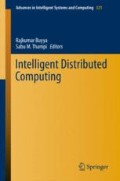Abstract
The focus of this paper is to use Cellular Automata for simulating a series of topology control algorithms in Wireless Sensor Network using various environments. In this paper, we introduced the use of cellular automata in Wireless sensor networks to control Topology. In the network the sensor nodes are redundantly deployed in the same field. Due to this redundant deployment the many nodes in the network have remained in their active state simultaneously. This causes reduction in the global energy of the network and step-up in the lifetime of the mesh. Thus, the principal aim of the topology control algorithms is to cut the initial topology of wireless sensor network by avoiding noise and hold out the life of the mesh.
Access this chapter
Tax calculation will be finalised at checkout
Purchases are for personal use only
Preview
Unable to display preview. Download preview PDF.
References
Chen, A., Kumar, S., Lai, T.H.: Local Barrier Coverage in Wireless Sensor Networks. Proc. IEEE 9(4) (April 2010)
Xing, G., Chang, X., Lu, C., Wang, J., Shen, K., Pless, R., O’Sullivan, J.A.: Efficient Coverage Maintenance Based on Probabilistic Distributed Detection. Proc. IEEE 9(9) (September 2010)
Razafindralambo, T., Simplot-Ryl, D.: Connectivity Preservation and Coverage Schemes for Wireless Sensor Networks. Proc. IEEE 56(10) (October 2011)
He, S., Chen, J., Li, X., (Sherman) Shen, X., Sun, Y.: Leveraging Prediction to Improve the Coverage of Wireless Sensor Networks. Proc. IEEE 23(4) (April 2012)
Liu, C., Cao, G.: Spatial-Temporal Coverage Optimization in Wireless Sensor Networks. Proc. IEEE 10(5) (April 2011)
Ammari, H.M., Das, S.K.: Centralized and Clustered k-Coverage Protocols for Wireless Sensor Networks. Proc. IEEE 61(1) (January 2012)
Wagh, S., Prasad, R.: Energy Optimization in Wireless Sensor Network through Natural Science Computing: A Survey
Nowak, M., May, R.: Evolutionary Games and Spatial Chaos. Nature 359(6398), 826–829 (1992), doi:10.1038/359826a0
Applebaum, B., Ishai, Y., Kushilevitz, E.: Cryptography by Cellular Automata or How Fast Complexity Can Emerge in Nature? In: Proceedings of the 1st Symposium on Innovations in Computer Science (ICS 2010), Beijing, January 5-7, pp. 1–19 (2010)
Beigy, H., Meybodi, M.R.: A Self-Organizing Channel Assignment Algorithm: A Cellular Learning Automata Approach. In: Liu, J., Cheung, Y.-M., Yin, H. (eds.) IDEAL 2003. LNCS, vol. 2690, pp. 119–126. Springer, Heidelberg (2003)
Ganguly, N., Sikdar, B.K., Deutsch, A., Canright, G., Chaudhuri, P.: A Survey on Cellular Automata. Technical Report, Centre for High Performance Computing, Dresden University of Technology, Dresden (2003)
Boondirek, A., Triampo, W., Nuttavut, N.: A Review of Cellular Automata Models of Tumor Growth. International Mathematical Forum 5(61), 3023–3029 (2010)
Tome, T., De Felicio, J.R.D.: Probabilistic Cellular Automata Describing a Biological Immune System. Physical Review E 53(4), 3976–3981 (1996), doi:10.1103/PhysRevE.53.3976
Gardner, M.: The Fantastic Combinations of John Conway’s New Solitaire Game ‘Life’. Scientific American 223, 120–123 (1970)
Chopard, B., Droz, M.: Cellular Automata Modeling of Physical Systems. Cambridge University Press, Cambridge (1998)
Ilachinski, A.: Cellular Automata: A Discrete Universe. World Scientific Publishing Co. Pte. Ltd., London (2001)
Wolfram, S.: A New Kind of Science. Wolfram Media, Inc., Champaign (2002)
Wolfram, S.: Theory and Applications of Cellular Automata. World Scientific, Singapore City (1986)
Author information
Authors and Affiliations
Editor information
Editors and Affiliations
Rights and permissions
Copyright information
© 2015 Springer International Publishing Switzerland
About this paper
Cite this paper
Bhende, M.S., Wagh, S. (2015). Extending Lifetime of Wireless Sensor Network Using Cellular Automata. In: Buyya, R., Thampi, S. (eds) Intelligent Distributed Computing. Advances in Intelligent Systems and Computing, vol 321. Springer, Cham. https://doi.org/10.1007/978-3-319-11227-5_10
Download citation
DOI: https://doi.org/10.1007/978-3-319-11227-5_10
Publisher Name: Springer, Cham
Print ISBN: 978-3-319-11226-8
Online ISBN: 978-3-319-11227-5
eBook Packages: EngineeringEngineering (R0)

